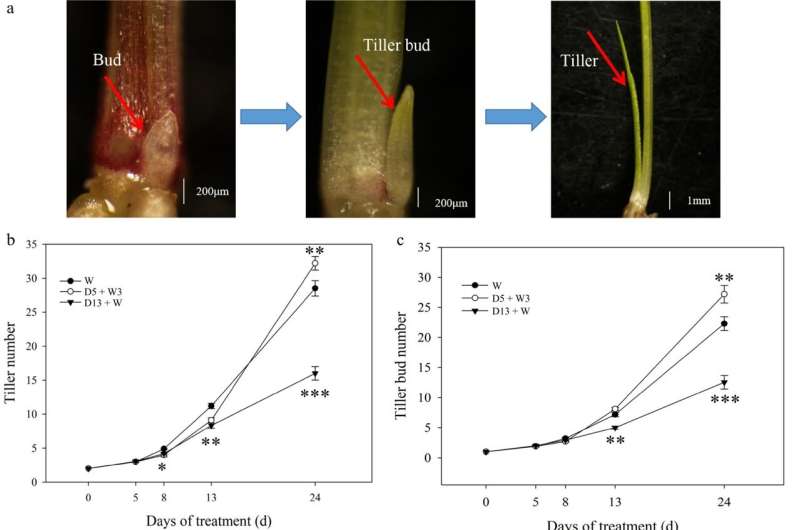This article has been reviewed according to Science X's editorial process and policies. Editors have highlighted the following attributes while ensuring the content's credibility:
fact-checked
trusted source
proofread
Mild drought preconditioning boosts tiller growth and resilience in perennial ryegrass

A research team has discovered that drought preconditioning accelerates tiller bud initiation and outgrowth in perennial ryegrass plants. This study revealed that mild drought stress followed by rewatering significantly promoted these processes through the regulation of key genes related to bud dormancy, activity, initiation, and outgrowth.
The findings suggest that managing water stress effectively could enhance crop production, particularly in water-limited environments, by leveraging hormonal changes involving abscisic acid (ABA), jasmonic acid (JA), and cytokinin (CK).
Water scarcity is a major constraint on crop production worldwide, and previous stress conditions can influence plant adaptation to subsequent environmental stresses. Many studies have shown that drought preconditioning can improve drought tolerance and enhance crop growth, though some studies have suggested that the improvement of drought tolerance by drought preconditioning may reduce biomass.
Tillering, essential for grass density and yield, involves complex genetic and hormonal regulation. Despite advances, little is known about the role of these factors in grass tiller development under drought preconditioning.
The study, published in Grass Research on 5 January 2024, elucidates the mechanisms by which drought preconditioning promotes tiller development in perennial ryegrass, focusing on gene expression and hormone regulation.
To investigate the effects of drought preconditioning on tiller development in perennial ryegrass, researchers implemented three treatments: W (well-watered), D5 + W3 (5 days of drought + three days of watering, followed by a five day period of water-withholding and subsequent rewatering for 11 days), and D13 + W (13 days of drought and were then rewatered for 11 days).
Observations revealed that the D5 + W3 treatment significantly increased both tiller number and bud number compared to the W treatment, particularly after 11 days of rewatering. During the D5 + W3 treatment, tiller numbers increased from 2 to 9, and after rewatering, they surged to 32.
Similarly, bud numbers rose from 1 to 8 and then to 27 post-rewatering. Gene expression analysis demonstrated that key genes involved in bud initiation, such as LpMOC1, LpLAX1, and LpLAX2, were significantly upregulated in the D5 + W3 treatment.
Additionally, LpDRM1 and LpARP, associated with bud dormancy, were lower in the D5 + W3 treatment, suggesting reduced dormancy. Hormonal analysis indicated higher levels of cytokinin (isopentenyladenine and trans-Zeatin-riboside) and stable levels of ABA and JA in the D5 + W3 treatment, correlating with enhanced tiller development.
Furthermore, genes related to cell division, such as LpPCNA and LpCycD2, were upregulated after rewatering, indicating resumed growth activity. Overall, the study suggests that mild drought preconditioning effectively promotes tiller growth through specific gene regulation and hormonal balance, offering valuable insights into optimizing water management for improving crop resilience and productivity under water-limited conditions.
According to the study's lead researcher, Lili Zhuang, "This research enriched our knowledge of the mechanisms of drought preconditioning. The methods of water management employed in this study are of great importance for increasing crop production in circumstances of water shortage."
In summary, this study found that mild drought preconditioning (D5 + W3 treatment) in perennial ryegrass accelerates tiller bud initiation and outgrowth through key gene alterations (LpDRM1, LpARP, LpPCNA, LpCycD2, LpMOC1, LpLAX1, LpLAX2, LpTB1, and LpD3) and hormonal changes (low ABA, high JA, and high CK).
These findings enhance our understanding of drought resilience and suggest strategies for optimizing water management to improve crop productivity in water-limited environments.
More information: Yunjia Ding et al, Transcriptional reprogramming of genes related to bud dormancy, outgrowth, and hormones for tiller development due to drought preconditioning in Lolium perenne, Grass Research (2023). DOI: 10.48130/gr-0023-0028
Provided by Chinese Academy of Sciences




















